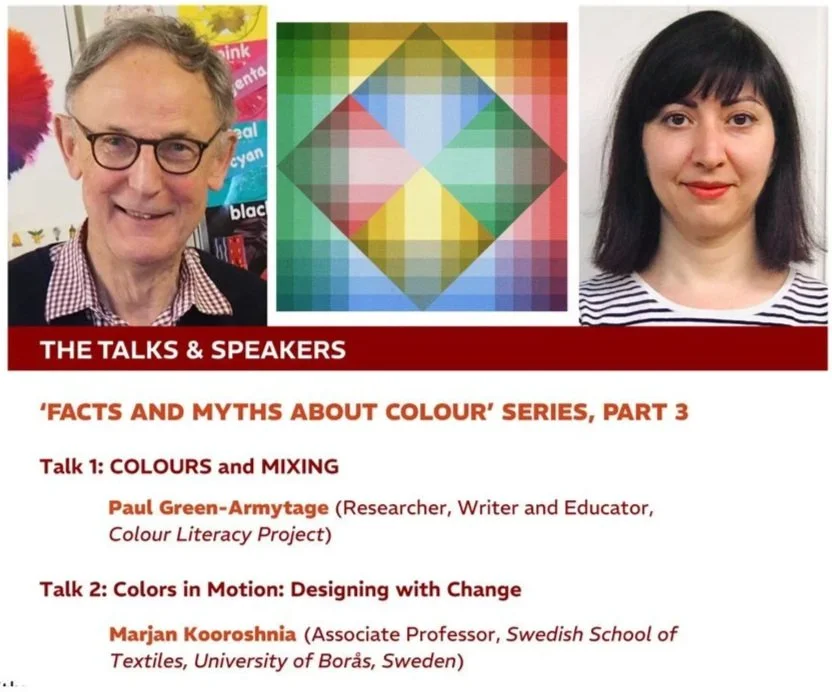Colour MIXconceptions: Comparative Mixing Processes
With: Paul Green-Armytage (Researcher, Writer & Educator) & Marjan Kooroshnia (Associate Professor at The Swedish School of Textiles, University of Borås, Sweden)
Friday October 10, 2025. 11:00am - 12:30pm ET
Facts and Myths about Colour Series, Part 3
Paul Green-Armytage (Researcher, Writer & Educator)
COLOURS AND MIXING
Yellow and blue make green. Yellow and blue make grey. Yellow and blue make white. Yellow and blue make pink. The results from these mixtures will be illustrated. The difference between the results is due to the differences in the mixing processes. But it is not yellow and blue as colours that are being mixed. It is paints, inks and lights. It is these that contribute to the stimulus that enters the eyes where the response triggers neural signals for transmission deeper into the brain. It is only in the brain that conscious sensations of colours are experienced. The Natural Colour System is a system of colour appearances and can be used to plot the results of mixing paints, inks, and lights, to reveal problems and possibilities. The term ‘primary colours’ is usually applied to the paints, inks and lights that are being mixed. But the term can also be applied to the attributes of appearance in the sensation such as yellowness or blueness. The term ‘complementary colours’ is also applied to pairs of paints, inks, or lights that can be mixed to produce a sensation of a neutral white or grey. Complementary lights mix additively to white. Complementary paints and inks mix subtractively to dark grey. Additive and subtractive mixtures do not deliver complementary colour pairs that appear the same. To reconcile a colour circle based on additive mixture with one based on subtractive mixture the colour circle can be treated as elastic so that intervals between colours can be stretched or compressed to move from one set of relationships to the other.
Paul Green-Armytage was born and educated in England, graduating as an architect. He had some ten years’ experience as a practising designer in England, Canada and Australia, working as an architect, exhibition designer and set designer for television, before taking up a position as senior lecturer in charge of the first year program in design at what is now Curtin University in Western Australia. Early in his academic career he developed a research interest in colour. Green-Armytage was awarded his PhD in 2005; his thesis was titled “Colour, Language and Design”. He has contributed papers at many national and international conferences, several by invitation, served as a member of the executive committee of the International Colour Association, and as president of the Colour Society of Australia. He is retired from teaching but remains active as a researcher, writer and educator, and has been a member of the Colour Literacy Project team from its launch in 2020.
Marjan Kooroshnia (Associate Professor at The Swedish School of Textiles, University of Borås, Sweden)
COLORS IN MOTION: DESIGNING WITH CHANGE
In this talk, a world of smart colors is unfolded—pigments that do not remain static, but respond, transform, and come alive. These are colors with agency, able to shift, fade, and return, constantly in dialogue with their surroundings. Through thermochromic pigments, heat and cold become design variables, as temperature itself becomes a brushstroke: hues deepen, dissolve, and reappear in fluid transitions. Patterns emerge and vanish, surfaces ripple with change, and objects acquire a living quality that resists permanence. Yet transformation is not limited to temperature alone. The interaction of RGB light with colored surfaces—even those coated with ordinary, familiar pigments—reveals another dimension of dynamism. With the flicker of a light source, patterns can appear, disappear, and reconfigure, bringing movement and rhythm to what we often think of as fixed. Through these explorations, textiles and surfaces are reimagined not as passive backdrops, but as active participants—storytellers that breathe, shift, and invite us into ever-changing narratives of color and light. In this unfolding world, colour is no longer something to be mixed once and for all, but something orchestrated—fluid, responsive, and alive.
Marjan Kooroshnia is a pioneering researcher and Associate Professor at The Swedish School of Textiles, University of Borås, Sweden. With a PhD in Textile Design, she explores the intersection of color, light, and materiality in textile and fashion design. Her research pushes the boundaries of traditional design through innovative uses of smart colors—such as thermochromic, photochromic, electroluminescent, and photoluminescent pigments—that create dynamic patterns. She also investigates how the interaction between RGB light and colored surfaces, can transform textiles into living, shifting expressions. By revealing new ways for textiles to change, her work opens up fresh design aesthetics, supports more sustainable practices, and inspires future directions in textile and fashion, interiors, and interactive experiences.



